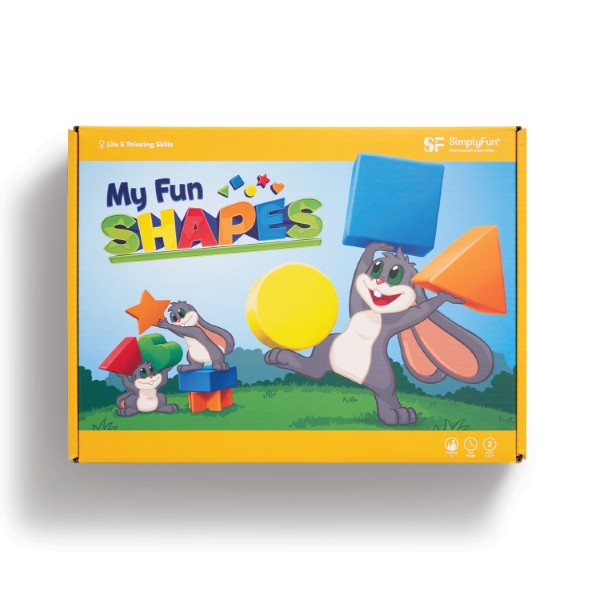
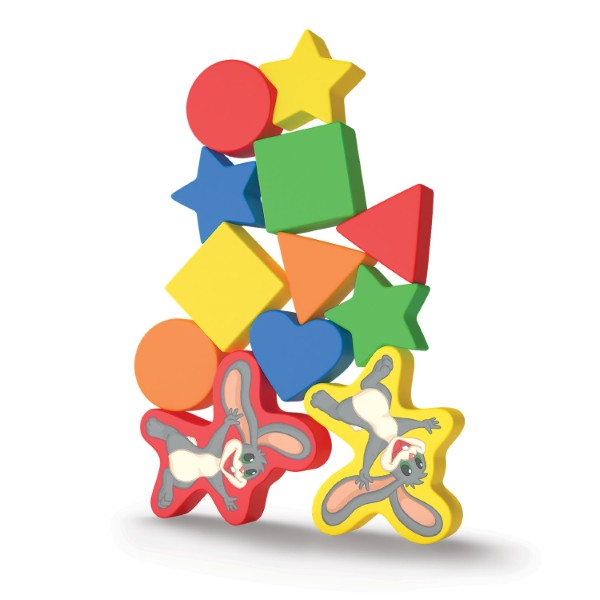
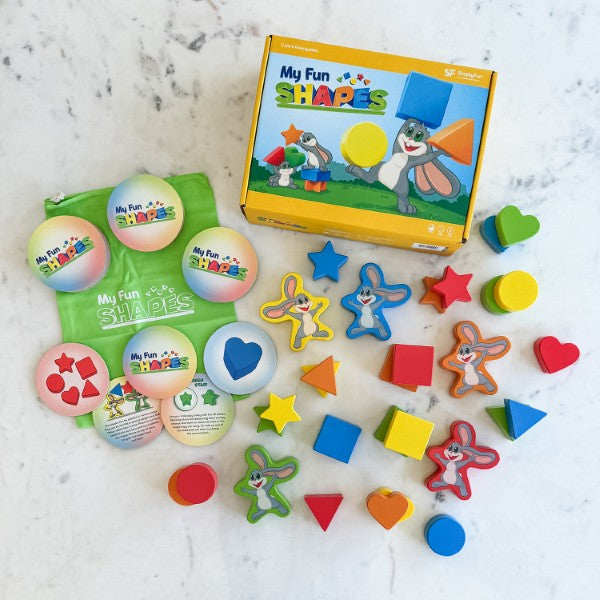
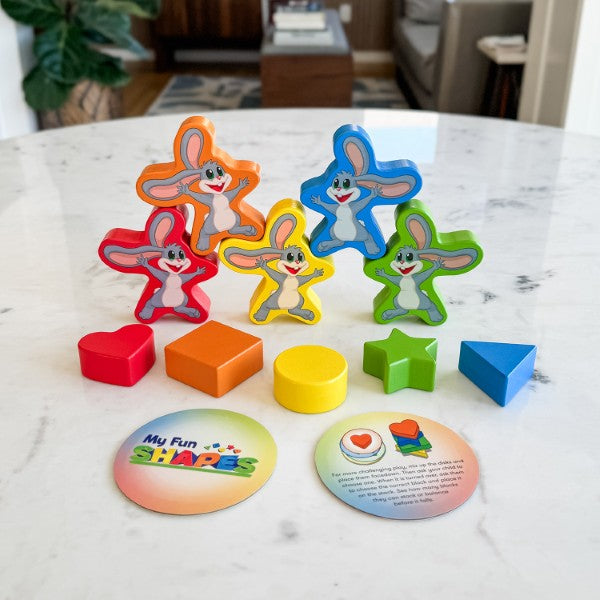
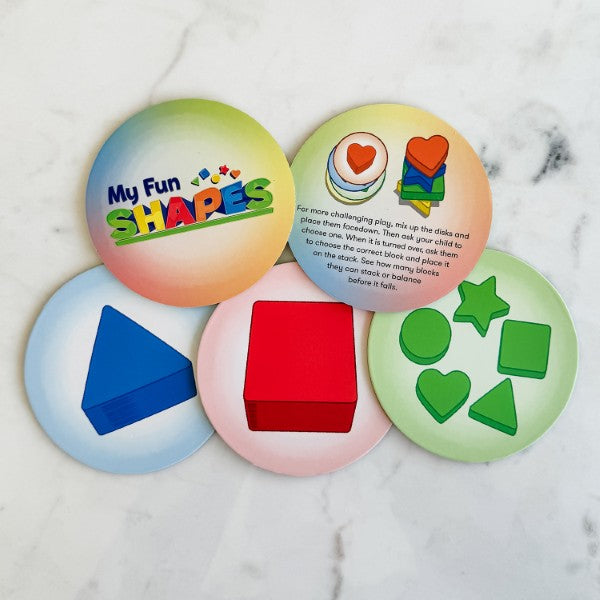
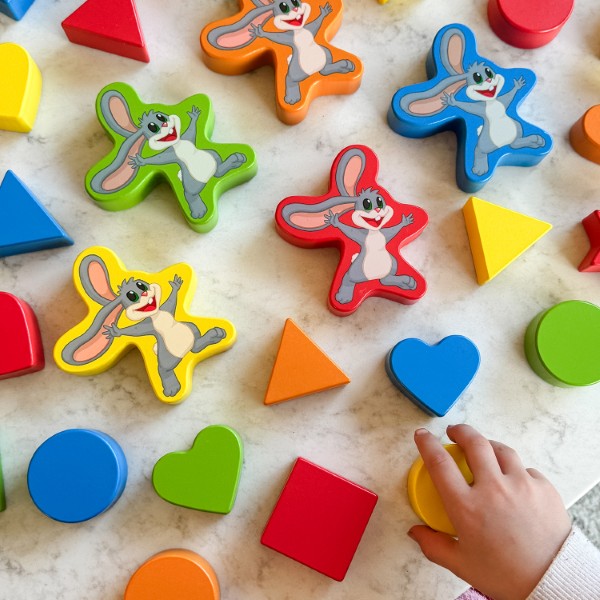
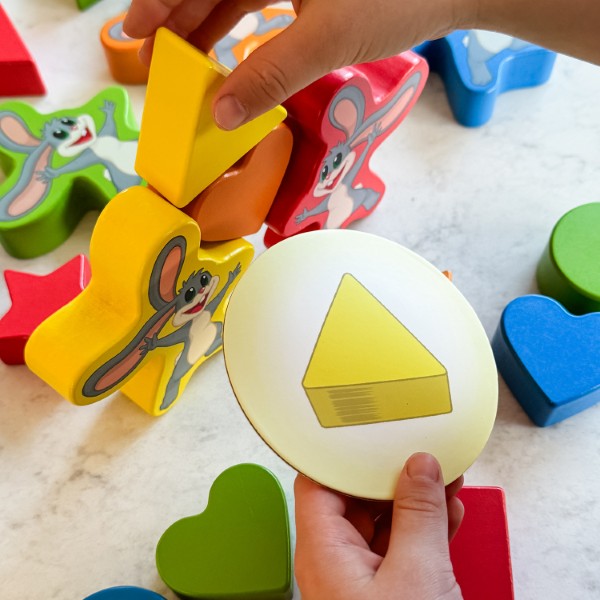
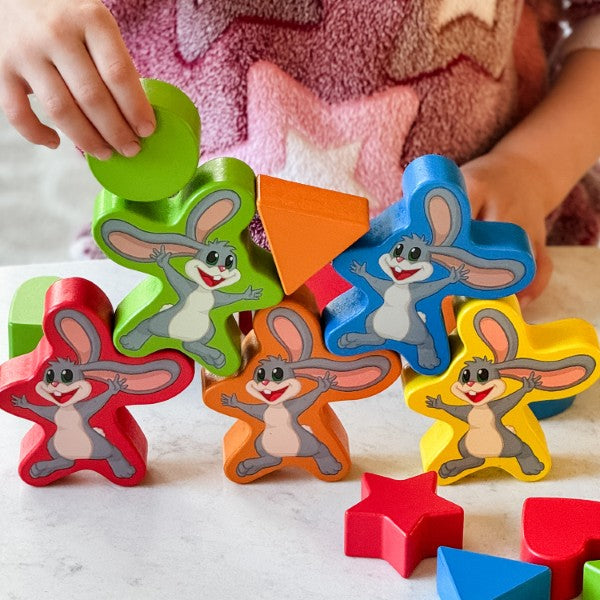
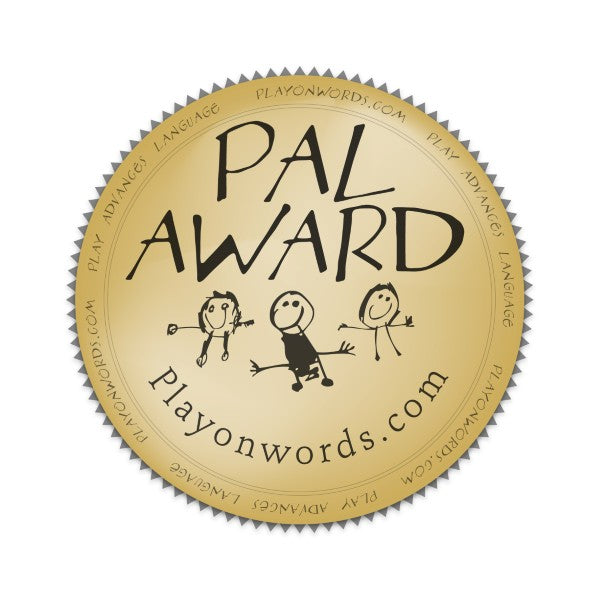



Collapsible content
You can enjoy My Fun Shapes with 1 or more players, ages 2 and up!
My Fun Shapes is great for helping your child with color and shape recognition.
My Fun Shapes also helps develop Fine Motor Skills as children stack and balance the blocks.
Unpack the 25 shape and 5 Tibbar rabbit blocks.
The activity disks can be used to add a challenge and help give ideas on how to stack and balance the blocks.
There are lots of ways to engage with your child and help them learn their colors and shapes. You can ask them to name the color or the shape they are using. Or hold up one of the activity disks and ask them to choose the matching block.
The blocks can be stacked in various ways. They can be laid flat or placed upright on a side. Tibbar rabbit likes to help. Place two or more rabbit blocks as a base and try to balance the shape blocks on top of them.
For more challenging play, mix up the disks face down and then ask your child to choose one. When it is turned over ask them to choose the correct block and place it on the stack. See how many blocks they can stack or balance before it falls.
You can also let your child play freely with the 30 blocks, stacking and balancing them as they choose.
Let your kids experiment and learn by stacking and balancing blocks, with SimplyFun’s My Fun Shapes!

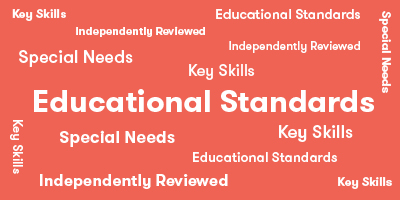

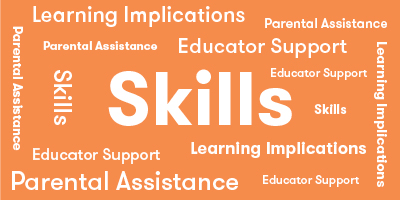
Explore
What Does Child Do To Use Skill In The Game?
Playing with My Fun Shapes involves exploring different ways to combine, stack and play with options for balancing the blocks and Tibbar shapes.
How Parents Can Assist Learning
Some of the included disks contain ideas and recommendations for how parents can encourage and support their child's nourishing play like stacking, comparing, matching and balancing.
Learning Implications and Educator Support
My Fun Shapes is a great developmental playset that supports fine motor, comparing, matching and geometry skill development for Pre-K children.
Educators can easily incorporate My Fun Shapes into their programs where they may already but using stacking, matching or color & shape activities.
Determine
What Does Child Do To Use Skill In The Game?
When stacking, players decide which shape to place next. When playing matching games, players need to determine which color or shape of block matches the image on the disk.
How Parents Can Assist Learning
It can be fun and increase engagement by taking turns with your child in stacking shapes on each other. This also gives you opportunity to show child the different ways you can orient and place a shape so that it balances well.
When children are first learning colors and shapes, say the colors and shapes while playing. Concentrate on one color at a time and one shape at a time. Show two blocks and ask, "Do you want blue or red?" (receptive language) or say, " I want a star block." (expressive language). When the child responds consistently correctly, add another color.
Learning Implications and Educator Support
Whether stacking or playing various matching games, My Fun Shapes involves observational, visual spatial and association skills as they examine and decide what shapes and colors to select.
Compare
What Does Child Do To Use Skill In The Game?
Closely related to determining, children need to compare colors and shapes in order to decide which to select. Additionally, players need to compare how and where they can place a shape to they will balance properly when stacked.
How Parents Can Assist Learning
Parents can take turns picking and stacking blocks. On their turn, hold two blocks and describe how they are different and why you are picking one over the other. Then, on the child's turn, encourage them to tell you why they picked a certain shape.
Learning Implications and Educator Support
Selecting and stacking shapes helps children learn situational analysis because they need to consider and compare the consequences of playing a certain block in a certain location.
For younger players, educators may need to remind them that block can be oriented in different ways. They can ask children questions to encourage them to make comparisons, such as, "Which side of this block do you think will balance better?" or, "Look at these two shapes (hold two different shapes like a cube and cylinder). How are they different from each other?"
Verbalizing is a good technique for strengthening the child's analytical abilities and problem-solving.
Remember
What Does Child Do To Use Skill In The Game?
The more children play, the more they will remember the names and colors of shapes, as well as how those shapes balance on top of others.
How Parents Can Assist Learning
No parent support is needed
Learning Implications and Educator Support
No educator support is needed.
Predict
What Does Child Do To Use Skill In The Game?
As players compare different shapes to stack, they are considering which will be easier or harder to balance.
How Parents Can Assist Learning
Parents can take turns picking and stacking blocks. On their turn, hold two blocks and describe how they are different and why you are picking one over the other. Then, on the child's turn, encourage them to tell you why they picked a certain shape.
Learning Implications and Educator Support
Selecting and stacking shapes helps children learn situational analysis because they need to consider and compare the consequences of playing a certain block in a certain location.
For younger players, educators may need to remind them that block can be oriented in different ways. They can ask children questions to encourage them to make comparisons, such as, "Which side of this block do you think will balance better?" or, "Look at these two shapes (hold two different shapes like a cube and cylinder). How are they different from each other?"
Verbalizing is a good technique for strengthening the child's analytical abilities and problem-solving.
Plan
What Does Child Do To Use Skill In The Game?
When children are making stacks of all one color or constructing an object like a tree, they are using their planning skills.
How Parents Can Assist Learning
If needed, encourage children to collect all the blocks they think they will need to complete a specific goal like stacking all the red shapes or making a tree.
Learning Implications and Educator Support
Planning with My Fun Shapes involves spatial reasoning, sequencing and, possibly, color or shape recognition.
If needed, use prompts and questions to encourage children to collect all the blocks they think they will need to complete a specific goal like stacking all the red shapes or making a tree.
Experiment
What Does Child Do To Use Skill In The Game?
Children are very likely to experiment with combining and stacking different shapes a variety of arrangements.
How Parents Can Assist Learning
No parent support is needed.
Learning Implications and Educator Support
Experimenting with My Fun Shapes is a great way for children to develop fine motor and spatial reasoning skills.
No educator support is needed.
Practice
What Does Child Do To Use Skill In The Game?
The more children play, the more they will remember the names and colors of shapes, as well as how those shapes balance on top of others.
How Parents Can Assist Learning
No parent support is needed
Learning Implications and Educator Support
No educator support is needed.
Solve
What Does Child Do To Use Skill In The Game?
Based on the activities on the disks or invented by parents or educators, players will need to select and place blocks in order to solve the challenge activity like stacking 10 blocks.
How Parents Can Assist Learning
Parents can help children by playing along with them as they do the activity disks or create their own towers of shapes. Ask questions like "Which blocks do you need to make a tree?" or "Which shape do you think I can put on top next?" or "I'm going to put my block here. Where are you going to put yours?"
Learning Implications and Educator Support
My Fun Shapes involves uses of visual spatial problem solving, balance and if/then problem solving.
As children master the fine motor skills required to play with the blocks, they learn new information constantly about what will balance versus cause stacks to fall over. This information directly effects how children strategize an approach for selecting and placing blocks.
Review
What Does Child Do To Use Skill In The Game?
Reviewing is not required but likely would happen if child is playing with adult.
Demonstrate
What Does Child Do To Use Skill In The Game?
Demonstrating is not required but likely would happen if child is playing with adult.
*Data compiled from CCSSI ELA Standards, WA Science Standards, and Washington Social Studies Standards

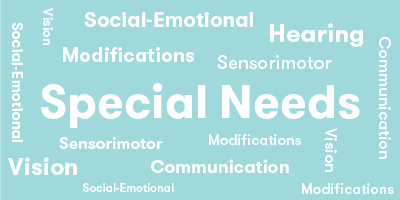
Cognitive
Suggestions for How to Modify Play Experience
Begin banging blocks together, making random arrangements, then lining them up. Stacking randomly comes next, then by shape. Balancing on Tibbar is more challenging.
Putting like colors together is a first step in learning colors. Pointing to a color is next, then labeling a color. Start play with just one color, then add a color as it learned.
Circle, square, and triangle come first in learning shapes. Name the shape and have the child feel the characteristics. Play with these first, then the other shapes can follow.
Communication
Suggestions for How to Modify Play Experience
Play with the blocks and name the colors and shapes. Concentrate on one color at a time and one shape at a time. Show two blocks and ask, "Do you want blue or red?" (receptive language) or say, " I want a red block?" (expressive language) When the child responds consistently correctly, add another color.
Sensorimotor
Suggestions for How to Modify Play Experience
The blocks in My Fun Shapes are wooden and of a good size for small hands. When children have fine motor problems, start with just two blocks. Place them next to each other, before placing them on top, so the child is successful.
Social Emotional/Behavioral
Suggestions for How to Modify Play Experience
Following the child's lead and taking turns by imitating them gives the child control and minimizes behavioral problems. To modify the child's actions, say, "I'm going to put my block here. Where are you going to put yours?"
Vision
Suggestions for How to Modify Play Experience
If the child is blind, they can feel the shapes and experiment with combining them in different ways.
Children who are color blind may not differentiate red and green, or blues and yellows, depending on the type of color blindness. Matching colors may, therefore, may too be difficult for them.
Hearing
Suggestions for How to Modify Play Experience
Hearing should not be a problem when playing the My Fun Shapes, although sign language may be needed for labeling colors and shapes.
*Data compiled from CCSSI ELA Standards, WA Science Standards, and Washington Social Studies Standards

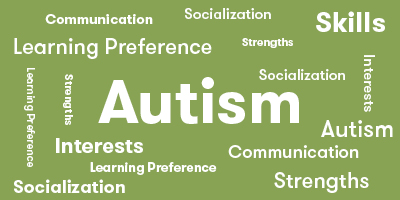
Autism Strengths & Interests
Short Summary of Strengths & Interests
- Shapes
- Colors
- Spatial Reasoning
Is good at matching visual items
Is This Game Appropriate? Yes
Description
Matching with the physical wooden blocks is the easiest level of play. Matching the blocks to the picture of the shape is a higher level.
Has a good memory for sensory details, including visual, touch, taste and smell
Is This Game Appropriate? No
Description
Vision and touch both play a part in learning to match physical shapes. The child can also combine shapes in a linear fashion, a pattern, or by stacking them into a tower. Encourage touching the parts of the shapes and labeling: the name of the shape, "angle" or "corner," "curve," "side," "top," and "bottom."
Has a good memory for words, phrases and dialouge
Is This Game Appropriate? No
Description
Encourage touching the parts of the shapes and Tibbars and labeling: the name of the shape, "angle" or "corner," "curve," "side," "top," and "bottom."
Has a good memory for pictures, numbers and patterns
Is This Game Appropriate? No
Description
The shapes can be used for creating patterns (circle, square, triangle, circle, square, triangle, etc.). Count the blocks in a tower or train. Find the shapes to put on the matching pictures from the included disks.
Likes to put things in order or a sequence
Is This Game Appropriate? No
Description
The shape blocks can be sequences in any number of ways: in a tower, in a line, in a pattern, or in a picture (shapes make a "face").
Learns through visualizing or "replaying" actions in their mind
This game is not appropriate
Likes activities with rules, such as math and phonics
This game is not appropriate
Is very concrete and literal
Is This Game Appropriate? Yes
Description
Using colored shape blocks is a great way for children to explore the characteristics of objects. The can use this information later as the explore other objects in the world.
Learns in small "chunks" (for example, phone numbers are 3 chunks of number xxx-xxx-xxxx that are combined together)
This game is not appropriate
Is good at nonverbal reasoning and logic
Is This Game Appropriate? Yes
Description
Comparing similarities and differences is the foundation for classification skills. Manipulation of the shape blocks enables children to discover these initial classification skills of color and shape.
Likes spatial problem solving
Is This Game Appropriate? Yes
Description
Exploring blocks is one of the first way children discover spatial reasoning about height, balance, orientation, and directionality.
Can read well with good vocabulary, though may not fully comprehend content
This game is not appropriate
Likes to use and has good fine motor skill
Is This Game Appropriate? Yes
Description
The blocks are great for practicing fine motor skills needed in stacking, lining up, and, balancing blocks on Tibbar.
Likes established routines or set ways of doing things
Is This Game Appropriate? Yes
Description
Exploration and discovery is what make My Fun Shapes fun for young children.
Likes manipulating, constructing or building things
Is This Game Appropriate? Yes
Description
That's what My Fun Shapes is all about!
Likes to use and has good musical abilities
This game is not appropriate
Likes to use and has good drawing skills
This game is not appropriate
Autism Special Considerations
Appears to ignore other's communication and/or has difficulty giving eye contact to a communication partner
Is This Game Appropriate for Child with Characteristic? Yes
Can Child with Characteristic Play Game w/o Modification? Yes
Strategies for Developing Compensatory Skills:
As long as the child is able to watch what others are doing with the shape blocks, eye contact is not needed for imitation of actions. Looking at the speaker is important for learning to match the word being said ("red square") with the corresponding block. Hold the block next to your mouth when labeling the block to encourage the child to look at how the word is formed.
Has difficulty understanding complex verbal directions
Is This Game Appropriate for Child with Characteristic? Yes
Can Child with Characteristic Play Game w/o Modification? No
Strategies for Developing Compensatory Skills:
Keep words and phrases short, so the child can understand what is said.
Uses vocabulary inaccurately or demonstrates echolalia (repeating another's speech)
Is This Game Appropriate for Child with Characteristic? Yes
Can Child with Characteristic Play Game w/o Modification? Yes
Strategies for Developing Compensatory Skills:
Echolalia (repetition) can be helpful if the child understands what the the other player is saying. Repeat what the child has said in imitation and demonstrate ("Yes. This is a red block.").
Gets stuck repeating a verbal topic or physical actions and/or has difficulty attending to others' actions or topic.
Is This Game Appropriate for Child with Characteristic? Yes
Can Child with Characteristic Play Game w/o Modification? Yes
Strategies for Developing Compensatory Skills:
Attending to others' actions is important for imitation of the adult's actions. Use exaggerated intonation and gestures to attract the child's attention to actions.
Has difficulty producing speech/communication
Is This Game Appropriate for Child with Characteristic? Yes
Can Child with Characteristic Play Game w/o Modification? Yes
Strategies for Developing Compensatory Skills:
Communication is not necessary for block play, but should be encouraged to support understanding and building vocabulary.
Has difficulty sequencing multi-step actions and/or doing complex abstract tasks
Is This Game Appropriate for Child with Characteristic? Yes
Can Child with Characteristic Play Game w/o Modification? No
Strategies for Developing Compensatory Skills:
Interaction with the blocks can be modified depending on the child's ability level. Adults can imitate the child's actions to encourage turn-taking, then add one new action as a model for the child to imitate.
Demonstrates difficulty initiating and maintaining social interactions
Is This Game Appropriate for Child with Characteristic? Yes
Can Child with Characteristic Play Game w/o Modification? No
Strategies for Developing Compensatory Skills:
Interaction with the blocks can be modified depending on the child's ability level. Adults can imitate the child's actions to encourage turn-taking, then add one new action as a model for the child to imitate. Comment on the child's actions to provide a model.
Acts out or demonstrates avoidance behaviors when frustrated, overwhelmed, or needs more sensory input.
Is This Game Appropriate for Child with Characteristic? Yes
Can Child with Characteristic Play Game w/o Modification? No
Strategies for Developing Compensatory Skills:
Depending on the child's sensory needs, lots of hugs with deep pressure prior to play may help the child self-calm. A weighted vest also may be helpful. If the child is throwing blocks, use a box or pan to throw the blocks into, making the child's actions into a game.
Has short attention span for non-preferred activities
Is This Game Appropriate for Child with Characteristic? Yes
Can Child with Characteristic Play Game w/o Modification? Yes
Strategies for Developing Compensatory Skills:
Change the activity with the blocks frequently. For example, once the child starts to look or move away, do something novel with the blocks to recapture the child's attention. For example, roll the round blocks or clap the blocks together, then place one on Tibbar.
Needs sameness or consistent routines and/or has difficulty with transitions from one activity to another
Is This Game Appropriate for Child with Characteristic? Yes
Can Child with Characteristic Play Game w/o Modification? No
Strategies for Developing Compensatory Skills:
Children with autism often perseverate, repeating limited actions. Play next to the child, imitating what the child does. Make one slight change to the child's pattern. For example, if the child is lining up blocks, imitate them; then add one block on top of the line of blocks, using exaggerated intonation and actions.
Has difficulty understanding others' feelings, intentions, and the reasons for others' actions.
Is This Game Appropriate for Child with Characteristic? Yes
Can Child with Characteristic Play Game w/o Modification? No
Strategies for Developing Compensatory Skills:
Use exaggerated facial expressions and gestures. The adult should talk about what they're doing and feeling as well as narrating what the child is doing and commenting on the emotions the child expresses.
*Data compiled from CCSSI ELA Standards, WA Science Standards, and Washington Social Studies Standards

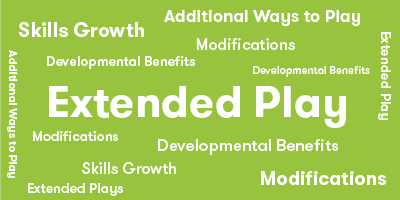
Extra Ways to Play the Game
Play a target game with the shape disks. Child can toss the right shape block onto the same shape disc
Materials Needed
No additional materials needed.
Developmental Benefits
In addition to encouraging matching, this modification requires spatial planning, arm and hand movements, and learning how to grade movements to throw with accuracy.
Extra Ways to Play the Game
Play bowling with the circle shapes rolled toward the same color Tibbar
Materials Needed
No additional materials needed.
Developmental Benefits
This modification requires matching colors, spatial planning, arm and hand movements, and learning how to grade movements to throw with accuracy.
Extra Ways to Play the Game
See how many shapes you can put on 1 Tibbar, 2 Tibbars, etc.
Materials Needed
No additional materials needed.
Developmental Benefits
Stacking on an uneven surface is challenging and requires experimenting with different orientations of shapes.
Extra Ways to Play the Game
Give the child a marker and let them draw faces or designs
Materials Needed
Washable markers
Developmental Benefits
Drawing enables the child to practice fine motor skills while they create faces or designs.
*Data compiled from CCSSI ELA Standards, WA Science Standards, and Washington Social Studies Standards
Game Details
- 25 Shape Blocks
- 5 Tumbling Tibbar Blocks
- 32 Activity Disks
- 1 Storage Bag
- Choosing a selection results in a full page refresh.
- Opens in a new window.














